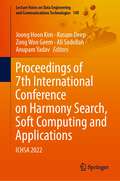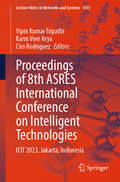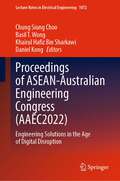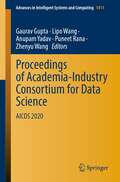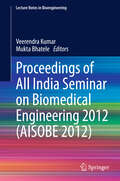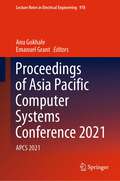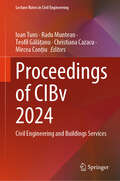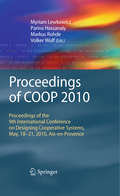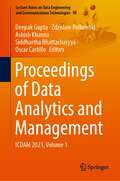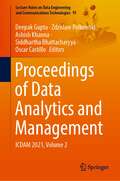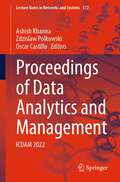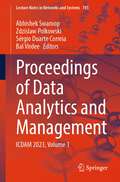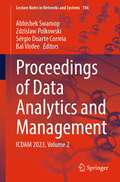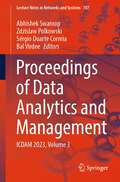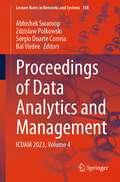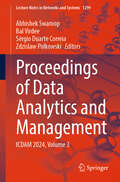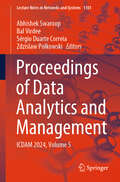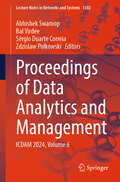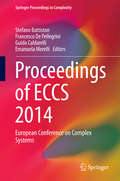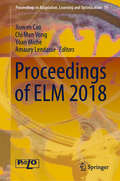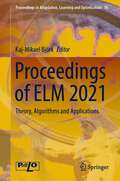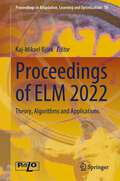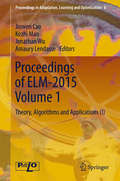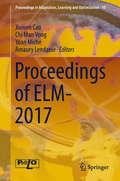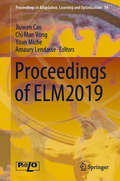- Table View
- List View
Proceedings of 7th International Conference on Harmony Search, Soft Computing and Applications: ICHSA 2022 (Lecture Notes on Data Engineering and Communications Technologies #140)
by Anupam Yadav Kusum Deep Joong Hoon Kim Zong Woo Geem Ali SadollahThe book covers different aspects of real-world applications of optimization algorithms. It provides insights from the Seventh International Conference on Harmony Search, Soft Computing and Applications held at Virtual Conference, Seoul, South Korea, in February 2022. Harmony search (HS) is one of the most popular metaheuristic algorithms, developed in 2001 by Prof. Joong Hoon Kim and Prof. Zong Woo Geem, that mimics the improvisation process of jazz musicians to seek the best harmony. The book consists of research articles on novel and newly proposed optimization algorithms; the theoretical study of nature-inspired optimization algorithms; numerically established results of nature-inspired optimization algorithms; and real-world applications of optimization algorithms and synthetic benchmarking of optimization algorithms.
Proceedings of 8th ASRES International Conference on Intelligent Technologies: ICIT 2023, Jakarta, Indonesia (Lecture Notes in Networks and Systems #1031)
by Karm Veer Arya Ciro Rodriguez Vipin Kumar TripathiThis book gathers the proceedings of the 8th International Conference on Intelligent Technologies (ICIT) held on December 15–17, 2023, at the Matana University, Jakarta, Indonesia. The respective contributions from industrial practitioners and researchers present advanced studies related to the application of intelligent technologies in various fields of research industry and society. This includes applications in a variety of fields such as computational intelligence, data science and engineering, communication and networking, signal and image processing, electrical devices, circuits systems, robotics, instrumentation, automation, biomedical, and health care.
Proceedings of ASEAN-Australian Engineering Congress: Engineering Solutions in the Age of Digital Disruption (Lecture Notes in Electrical Engineering #1072)
by Chung Siung Choo Basil T. Wong Khairul Hafiz Bin Sharkawi Daniel KongThis book presents the proceedings of the ASEAN-Australian Engineering Congress (AAEC2022), held as a virtual event, 13–15 July 2022 with the theme “Engineering Solutions in the Age of Digital Disruption”. The book presents selected papers covering scientific research in the field of Engineering Computing, Network, Communication and Cybersecurity, Artificial Intelligence & Machine Learning, Materials Science & Manufacturing, Automation and Sensors, Smart Energy & Cities, Simulation & Optimisation and other Industry 4.0 related Technologies. The book appeals to researchers, academics, scientists, students, engineers and practitioners who are interested in the latest developments and applications related to addressing the Fourth Industrial Revolution (IR4.0).
Proceedings of Academia-Industry Consortium for Data Science: AICDS 2020 (Advances in Intelligent Systems and Computing #1411)
by Gaurav Gupta Anupam Yadav Zhenyu Wang Lipo Wang Puneet RanaThis book gathers high-quality papers presented at Academia-Industry Consortium for Data Science (AICDS 2020), held in Wenzhou, China during 19 – 20 December 2020. The book presents views of academicians and also how companies are approaching these challenges organizationally. The topics covered in the book are data science and analytics, natural language processing, predictive analytics, artificial intelligence, machine learning, deep learning, big data computing, cognitive computing, data visualization, image processing, and optimization techniques.
Proceedings of All India Seminar on Biomedical Engineering 2012 (AISOBE #2012)
by Mukta Bhatele Veerendra KumarThis book is a collection of articles presented by researchers and practitioners, including engineers, biologists, health professionals and informatics/computer scientists, interested in both theoretical advances and applications of information systems, artificial intelligence, signal processing, electronics and other engineering tools in areas related to biology and medicine in the All India Seminar on Biomedical Engineering 2012 (AISOBE 2012), organized by The Institution of Engineers (India), Jabalpur Local Centre, Jabalpur, India during November 3-4, 2012. The content of the book is useful to doctors, engineers, researchers and academicians as well as industry professionals.
Proceedings of Asia Pacific Computer Systems Conference 2021: APCS 2021 (Lecture Notes in Electrical Engineering #978)
by Emanuel Grant Anu GokhaleThis book contains select proceedings papers from the Asia Pacific Computer Systems Conference (APCS 2022). The contents focus on the design and implementation of languages, data models, process models, algorithms, software and hardware for information systems. The chapters also include contributions on data mining and knowledge discovery addressing detailed descriptions of significant applications. This book proves a valuable resource for those in academia and industry interested in computational intelligence, artificial intelligence and automation.
Proceedings of CIBv 2024: Civil Engineering and Buildings Services (Lecture Notes in Civil Engineering #665)
by Ioan Tuns Radu Muntean Christiana Cazacu Teofil Gălățanu Mircea ConțiuThis book gathers the proceedings of the 19th International Conference on Civil Engineering and Buildings Services (CIBv), held in Brașov, Romania, on November 7–8, 2024. It covers highly diverse topics such as structural analysis and optimization, concrete, steel and timber structures, computer aided design of structures, railways, roads and bridges, geotechnics and foundations, experimental methods in the investigation of structures, new and improved building materials, risk assessment of natural hazards, advanced energy design for HVAC installations, energy performance of buildings, and efficient buildings. Written by leading researchers and engineers, and selected by means of a rigorous international peer-review process, the contributions highlight numerous exciting ideas that will spur novel research directions and foster multidisciplinary collaborations.
Proceedings of COOP 2010
by Parina Hassanaly Volker Wulf Markus Rohde Myriam LewkowiczCOOP 2010 is the 9th edition of the International Conference on Designing Cooperative Systems, being the second European conference in the field of Computer Supported Cooperative Work after ECSCW. The conference brings together researchers who contribute to the analysis and design of cooperative systems and their integration in organizational community, public and other settings, and their implications for policy and decision making. Cooperative systems design requires a deep understanding of collective activities, involving both artifacts and social practices. Contributions are solicited from a wide range of domains contributing to the fields of cooperative systems design and evaluation: CSCW, HCI, Information Systems, Knowledge Engineering, Multi-agents, organizational and management sciences, sociology, psychology, anthropology, ergonomics, linguistics.
Proceedings of Data Analytics and Management: ICDAM 2021, Volume 1 (Lecture Notes on Data Engineering and Communications Technologies #90)
by Oscar Castillo Siddhartha Bhattacharyya Deepak Gupta Ashish Khanna Zdzislaw PolkowskiThis book includes original unpublished contributions presented at the International Conference on Data Analytics and Management (ICDAM 2021), held at Jan Wyzykowski University, Poland, during June 2021. The book covers the topics in data analytics, data management, big data, computational intelligence, and communication networks. The book presents innovative work by leading academics, researchers, and experts from industry which is useful for young researchers and students.
Proceedings of Data Analytics and Management: ICDAM 2021, Volume 2 (Lecture Notes on Data Engineering and Communications Technologies #91)
by Oscar Castillo Siddhartha Bhattacharyya Deepak Gupta Ashish Khanna Zdzislaw PolkowskiThis book includes original unpublished contributions presented at the International Conference on Data Analytics and Management (ICDAM 2021), held at Jan Wyzykowski University, Poland, during June 2021. The book covers the topics in data analytics, data management, big data, computational intelligence, and communication networks. The book presents innovative work by leading academics, researchers, and experts from industry which is useful for young researchers and students.
Proceedings of Data Analytics and Management: ICDAM 2022 (Lecture Notes in Networks and Systems #572)
by Oscar Castillo Ashish Khanna Zdzislaw PolkowskiThis book includes original unpublished contributions presented at the International Conference on Data Analytics and Management (ICDAM 2022), held at tThe Karkonosze University of Applied Sciences, Poland, during June 2022. The book covers the topics in data analytics, data management, big data, computational intelligence, and communication networks. The book presents innovative work by leading academics, researchers, and experts from industry which is useful for young researchers and students.
Proceedings of Data Analytics and Management: ICDAM 2023, Volume 1 (Lecture Notes in Networks and Systems #785)
by Zdzislaw Polkowski Abhishek Swaroop Sérgio Duarte Correia Bal VirdeeThis book includes original unpublished contributions presented at the International Conference on Data Analytics and Management (ICDAM 2023), held at London Metropolitan University, London, UK, during June 2023. The book covers the topics in data analytics, data management, big data, computational intelligence, and communication networks. The book presents innovative work by leading academics, researchers, and experts from industry which is useful for young researchers and students. The book is divided into four volumes.
Proceedings of Data Analytics and Management: ICDAM 2023, Volume 2 (Lecture Notes in Networks and Systems #786)
by Zdzislaw Polkowski Abhishek Swaroop Sérgio Duarte Correia Bal VirdeeThis book includes original unpublished contributions presented at the International Conference on Data Analytics and Management (ICDAM 2023), held at London Metropolitan University, London, UK, during June 2023. The book covers the topics in data analytics, data management, big data, computational intelligence, and communication networks. The book presents innovative work by leading academics, researchers, and experts from industry which is useful for young researchers and students. The book is divided into four volumes.
Proceedings of Data Analytics and Management: ICDAM 2023, Volume 3 (Lecture Notes in Networks and Systems #787)
by Zdzislaw Polkowski Abhishek Swaroop Sérgio Duarte Correia Bal VirdeeThis book includes original unpublished contributions presented at the International Conference on Data Analytics and Management (ICDAM 2023), held at London Metropolitan University, London, UK, during June 2023. The book covers the topics in data analytics, data management, big data, computational intelligence, and communication networks. The book presents innovative work by leading academics, researchers, and experts from industry which is useful for young researchers and students. The book is divided into four volumes.
Proceedings of Data Analytics and Management: ICDAM 2023, Volume 4 (Lecture Notes in Networks and Systems #788)
by Zdzislaw Polkowski Abhishek Swaroop Sérgio Duarte Correia Bal VirdeeThis book includes original unpublished contributions presented at the International Conference on Data Analytics and Management (ICDAM 2023), held at London Metropolitan University, London, UK, during June 2023. The book covers the topics in data analytics, data management, big data, computational intelligence, and communication networks. The book presents innovative work by leading academics, researchers, and experts from industry which is useful for young researchers and students. The book is divided into four volumes.
Proceedings of Data Analytics and Management: ICDAM 2024, Volume 3 (Lecture Notes in Networks and Systems #1299)
by Zdzislaw Polkowski Abhishek Swaroop Sérgio Duarte Correia Bal VirdeeThis book includes original unpublished contributions presented at the International Conference on Data Analytics and Management (ICDAM 2024), held at London Metropolitan University, London, UK, during June 2024. The book covers the topics in data analytics, data management, big data, computational intelligence, and communication networks. The book presents innovative work by leading academics, researchers, and experts from industry which is useful for young researchers and students. The book is divided into six volumes.
Proceedings of Data Analytics and Management: ICDAM 2024, Volume 5 (Lecture Notes in Networks and Systems #1301)
by Zdzislaw Polkowski Abhishek Swaroop Sérgio Duarte Correia Bal VirdeeThis book includes original unpublished contributions presented at the International Conference on Data Analytics and Management (ICDAM 2024), held at London Metropolitan University, London, UK, during June 2024. The book covers the topics in data analytics, data management, big data, computational intelligence, and communication networks. The book presents innovative work by leading academics, researchers, and experts from industry which is useful for young researchers and students. The book is divided into six volumes.
Proceedings of Data Analytics and Management: ICDAM 2024, Volume 6 (Lecture Notes in Networks and Systems #1302)
by Zdzislaw Polkowski Abhishek Swaroop Sérgio Duarte Correia Bal VirdeeThis book includes original unpublished contributions presented at the International Conference on Data Analytics and Management (ICDAM 2024), held at London Metropolitan University, London, UK, during June 2024. The book covers the topics in data analytics, data management, big data, computational intelligence, and communication networks. The book presents innovative work by leading academics, researchers, and experts from industry which is useful for young researchers and students. The book is divided into six volumes.
Proceedings of ECCS 2014
by Stefano Battiston Francesco De Pellegrini Guido Caldarelli Emanuela MerelliThis work provides a careful selection of extended contributions presented at the 2014 ECCS conference and its satellite meetings, reflecting the scope and diversity of both fundamental and applied research areas in the field. The ECCS meeting, held under the patronage of the Complex Systems Society, is an annual event that has become the leading European conference devoted to complexity science. It presents cutting-edge research and offers a unique opportunity to study novel scientific approaches in a multitude of application areas. ECCS'14, the eleventh annual event, took place in Lucca, Italy. It gathered some 650 scholars representing a wide range of topics related to complex systems research, with emphasis on interdisciplinary approaches. The editors are leading specialists in the area. The book is of great interest to scientists, researchers and graduate students in complexity, complex systems and networks.
Proceedings of ELM 2018 (Proceedings in Adaptation, Learning and Optimization #11)
by Jiuwen Cao Amaury Lendasse Yoan Miche Chi Man VongThis book contains some selected papers from the International Conference on Extreme Learning Machine 2018, which was held in Singapore, November 21–23, 2018. This conference provided a forum for academics, researchers and engineers to share and exchange R&D experience on both theoretical studies and practical applications of the ELM technique and brain learning.Extreme Learning Machines (ELM) aims to enable pervasive learning and pervasive intelligence. As advocated by ELM theories, it is exciting to see the convergence of machine learning and biological learning from the long-term point of view. ELM may be one of the fundamental “learning particles” filling the gaps between machine learning and biological learning (of which activation functions are even unknown). ELM represents a suite of (machine and biological) learning techniques in which hidden neurons need not be tuned: inherited from their ancestors or randomly generated. ELM learning theories show that effective learning algorithms can be derived based on randomly generated hidden neurons (biological neurons, artificial neurons, wavelets, Fourier series, etc.) as long as they are nonlinear piecewise continuous, independent of training data and application environments. Increasingly, evidence from neuroscience suggests that similar principles apply in biological learning systems. ELM theories and algorithms argue that “random hidden neurons” capture an essential aspect of biological learning mechanisms as well as the intuitive sense that the efficiency of biological learning need not rely on computing power of neurons. ELM theories thus hint at possible reasons why the brain is more intelligent and effective than current computers. The main theme of ELM2018 is Hierarchical ELM, AI for IoT, Synergy of Machine Learning and Biological Learning.This book covers theories, algorithms and applications of ELM. It gives readers a glance at the most recent advances of ELM.
Proceedings of ELM 2021: Theory, Algorithms and Applications (Proceedings in Adaptation, Learning and Optimization #16)
by Kaj-Mikael BjörkThis book contains papers from the International Conference on Extreme Learning Machine 2021, which was held in virtual on December 15–16, 2021. Extreme learning machines (ELM) aims to enable pervasive learning and pervasive intelligence. As advocated by ELM theories, it is exciting to see the convergence of machine learning and biological learning from the long-term point of view. ELM may be one of the fundamental `learning particles’ filling the gaps between machine learning and biological learning (of which activation functions are even unknown). ELM represents a suite of (machine and biological) learning techniques in which hidden neurons need not be tuned: inherited from their ancestors or randomly generated. ELM learning theories show that effective learning algorithms can be derived based on randomly generated hidden neurons (biological neurons, artificial neurons, wavelets, Fourier series, etc.) as long as they are nonlinear piecewise continuous, independent of training data and application environments. Increasingly, evidence from neuroscience suggests that similar principles apply in biological learning systems. ELM theories and algorithms argue that “random hidden neurons” capture an essential aspect of biological learning mechanisms as well as the intuitive sense that the efficiency of biological learning need not rely on computing power of neurons. ELM theories thus hint at possible reasons why the brain is more intelligent and effective than current computers. This conference provides a forum for academics, researchers, and engineers to share and exchange R&D experience on both theoretical studies and practical applications of the ELM technique and brain learning. This book covers theories, algorithms, and applications of ELM. It gives readers a glance of the most recent advances of ELM.
Proceedings of ELM 2022: Theory, Algorithms and Applications (Proceedings in Adaptation, Learning and Optimization #18)
by Kaj-Mikael BjörkThis book contains selected papers from the 12th International Conference on Extreme Learning Machines 2022. Extreme learning machines (ELMs) continue to be an important complement to the many deep learning models you can find in the machine learning domain. ELM is fast and therefore suitable for many applications (not only in edge computing), and therefore there is a need to gather examples of possible applications. These proceedings, for the ELM 2022 conference, cover several application areas with relevant topics, where ELM can be used and has been used with great success. Here you will find several new areas (gaming, for instance) as well as improved concepts for existing application areas (signature forgery, for instance), where ELM has been implemented. In addition, some method improvements are also covered in this book, more specifically on the topic of 2nd-order Ordinary Differential Equations (ODEs).
Proceedings of ELM-2015 Volume 2
by Jonathan Wu Kezhi Mao Jiuwen Cao Amaury LendasseThis book contains some selected papersfrom the International Conference on Extreme Learning Machine 2015,which was held in Hangzhou, China,December 15-17,2015. This conference brought together researchers and engineers to share andexchange R&D experience on both theoretical studies and practicalapplications of the Extreme Learning Machine (ELM) technique and brainlearning. This book covers theories, algorithms adapplications of ELM. It gives readers a glance of the most recent advances ofELM.
Proceedings of ELM-2017 (Proceedings in Adaptation, Learning and Optimization #10)
by Jiuwen Cao Amaury Lendasse Yoan Miche Chi Man VongThis book contains some selected papers from the International Conference on Extreme Learning Machine (ELM) 2017, held in Yantai, China, October 4–7, 2017. The book covers theories, algorithms and applications of ELM.Extreme Learning Machines (ELM) aims to enable pervasive learning and pervasive intelligence. As advocated by ELM theories, it is exciting to see the convergence of machine learning and biological learning from the long-term point of view. ELM may be one of the fundamental `learning particles’ filling the gaps between machine learning and biological learning (of which activation functions are even unknown). ELM represents a suite of (machine and biological) learning techniques in which hidden neurons need not be tuned: inherited from their ancestors or randomly generated. ELM learning theories show that effective learning algorithms can be derived based on randomly generated hidden neurons (biological neurons, artificial neurons, wavelets, Fourier series, etc) as long as they are nonlinear piecewise continuous, independent of training data and application environments. Increasingly, evidence from neuroscience suggests that similar principles apply in biological learning systems. ELM theories and algorithms argue that “random hidden neurons” capture an essential aspect of biological learning mechanisms as well as the intuitive sense that the efficiency of biological learning need not rely on computing power of neurons. ELM theories thus hint at possible reasons why the brain is more intelligent and effective than current computers. This conference will provide a forum for academics, researchers and engineers to share and exchange R&D experience on both theoretical studies and practical applications of the ELM technique and brain learning. It gives readers a glance of the most recent advances of ELM.
Proceedings of ELM2019 (Proceedings in Adaptation, Learning and Optimization #14)
by Jiuwen Cao Amaury Lendasse Yoan Miche Chi Man VongThis book contains some selected papers from the International Conference on Extreme Learning Machine 2019, which was held in Yangzhou, China, December 14–16, 2019. Extreme Learning Machines (ELMs) aim to enable pervasive learning and pervasive intelligence. As advocated by ELM theories, it is exciting to see the convergence of machine learning and biological learning from the long-term point of view. ELM may be one of the fundamental ‘learning particles’ filling the gaps between machine learning and biological learning (of which activation functions are even unknown). ELM represents a suite of (machine and biological) learning techniques in which hidden neurons need not be tuned: inherited from their ancestors or randomly generated. ELM learning theories show that effective learning algorithms can be derived based on randomly generated hidden neurons (biological neurons, artificial neurons, wavelets, Fourier series, etc) as long as they are nonlinear piecewise continuous, independent of training data and application environments. Increasingly, evidence from neuroscience suggests that similar principles apply in biological learning systems. ELM theories and algorithms argue that “random hidden neurons” capture an essential aspect of biological learning mechanisms as well as the intuitive sense that the efficiency of biological learning need not rely on computing power of neurons. ELM theories thus hint at possible reasons why the brain is more intelligent and effective than current computers. The main theme of ELM2019 is Hierarchical ELM, AI for IoT, Synergy of Machine Learning and Biological Learning.This conference provides a forum for academics, researchers and engineers to share and exchange R&D experience on both theoretical studies and practical applications of the ELM technique and brain learning.This book covers theories, algorithms and applications of ELM. It gives readers a glance of the most recent advances of ELM.
